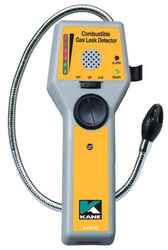
Posted to News on 12th Nov 2014, 16:38
Gas detection from past to present
Testing for gasses has come a long way since the days when Victorian miners would take a canary down a mineshaft as an early warning indicator of toxic gases such as carbon monoxide, methane or carbon dioxide. This article outlines some of the options available today for gas leakage testing, and Intrinsically Safe instruments for other testing applications.

The 19th Century scientist John Scott Haldene investigated mine explosions, which spurred him on to experiments with animals. He demonstrated that canaries show signs of distress when breathing in carbon dioxide.
This led to the Coal Mines Act 1911 which made it mandatory to use canaries in mines and, surprisingly, this practice continued in Britain until 1987, by which time more sophisticated methods and testing equipment had been developed.
Fast-forward to the 21st Century and gas detection equipment has evolved beyond recognition as modern-day gas leakage detectors, flue gas analysers and intrinsically safe testing equipment.
The most common form of gas leakage detector is for combustible gasses and start from as low as 40 for occasional testing equipment. For example, the Extech FG100 Combustible Gas Leak Detector will test for combustible gases like liquefied natural gas (LNG) and liquefied propane gas (LPG) from 500 to 6500 parts per million (ppm). Featuring sensitive detection circuitry, it provides both audible and visual alarms with continuous operation up to four hours and has separate LED indicators for gas leakage and static electricity.
For more intensive use, the Kane LS1/B Leak Seaka combustible gas leak detector (pictured) detects any combustible hydrocarbon gas in concentrations above 10ppm. A long flexible gooseneck probe with illuminated tip can be manoeuvred into difficult to access spaces. A built-in thumbwheel allows the user to filter out the effects of background gas, locating the leak source in less than one second. The sensitivity of the instrument may be adjusted to maintain accuracy.
At the top end of the market for gas leakage detectors is the Testo Gas Detector which measures natural gas, methane and propane limits with instant audible response if lower explosion limits are reached. Gas concentrations are measured by a semiconductor sensor and displayed to a resolution of 1ppm.
Intrinsically safe testing equipment
Testing for gasses is one thing, but where explosive gasses are routinely present, it makes sense to use intrinsically safe testing equipment. Intrinsic safety devices are purpose-built to stop potential dangerous sparks or other damaging heating effects when working in volatile environments. These tools are essential for those who work in hazardous environments.
For example, the Fluke 725Ex intrinsically safe multifunction process calibrator has full certification for testing machinery in explosive atmospheres. It is also compatible with Fluke's range of 700PEx pressure modules which are also made for use in explosive gas environments, which enable pressure measurements to 300psi or 200bar, allowing calibration of pressure transmitters. A pressure switch test function is also included which allows capture of sets, reset and deadband values.
Similarly, the Beamex MC2-IS Intrinsically Safe Calibrator connects to almost 20 available Beamex intrinsically safe pressure modules. It can be used in combination with various appliances and systems to measure pressure, current, voltage and frequency with built-in voltage, frequency and pulse generation plus mV measurement/simulation, resistance measurement/simulation, RTD measurement/simulation and TC measurement/simulation.
For further information please about gas leakage testing visit www.tester.co.uk.
PASS (Portable Appliance Safety Services Ltd)
1 Wilson Street
Thornaby
TS17 7AR
UNITED KINGDOM
+44 (0)845 365 4050






